If you’re growing tomatoes in the Northeast, you’re likely growing tomato diseases, as well.
Here is how to identify the four most common tomato diseases here in the Northeast and what to do next. New diseases are always evolving for plants as well as humxns, so we’ve added a link with more info about an emerging new virus, Brown Rugose, as well.
for even more detail, hop into our free online course Growing Tomatoes Organically!
1. Blossom-End Rot
Blossom-End Rot is an abysmal disappointment that is both manageable and preventable. Affecting paste and roma types more than other tomatoes, blossom-end rot is mostly an issue with the first set of fruit, quickly disappearing once conditions shift for the better.
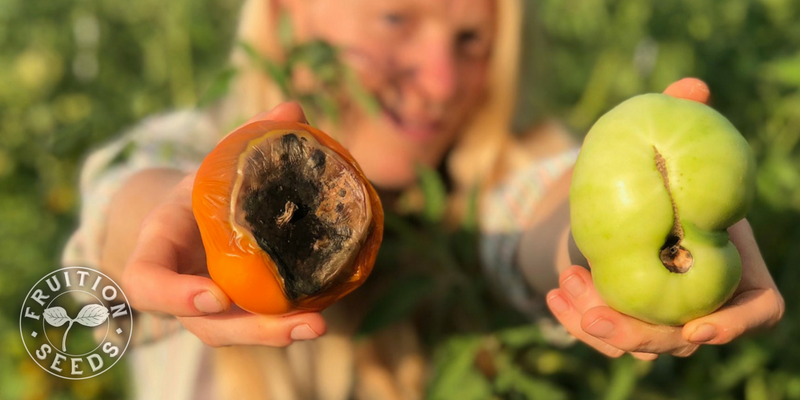
Remove fruits affected by blossom-end rot as early as possible (like the fruit on the right), since the next flush will likely not be affected.
Symptoms: black, leathery lesion at the blossom-end of the fruit, often visible when fruit is still green and quite small, becoming larger as the fruit matures.
Cause: Calcium deficiency. More accurately, it’s a water deficiency. Here is how I visualize it: Calcium is a huge ion while others are small, so calcium needs more water to be absorbed and moved around plants. Think of calcium as a large freighter, needing way more water to move about than a kayak. If your plants have experienced any level of drought, they are more susceptible to blossom-end rot.
Management: Strip affected fruits. Water evenly and deeply. Spraying dilute fish emulsion will make additional calcium available for your tomatoes, as well.
Prevention: Water evenly and deeply in periods of hot, dry weather. Spray dilute fish emulsion every two weeks.
Seed Saving: Though blossom-end rot is not seed-borne, it’s best to only save seed from unblemished fruits.
2. Late Blight
Late Blight is, without question, the most consistently disastrous tomato disease here in the Northeast. Each year its fungal spores travel north on the wind from climates that don’t freeze. Some years it arrives in Zone 5 by in July, other years mid-August. The USDA shares a Late Blight tracking map so we can anticipate when to start seriously scouting. Though there is no silver bullet, there’s much we can do to prevent tomato diseases, including Late Blight.
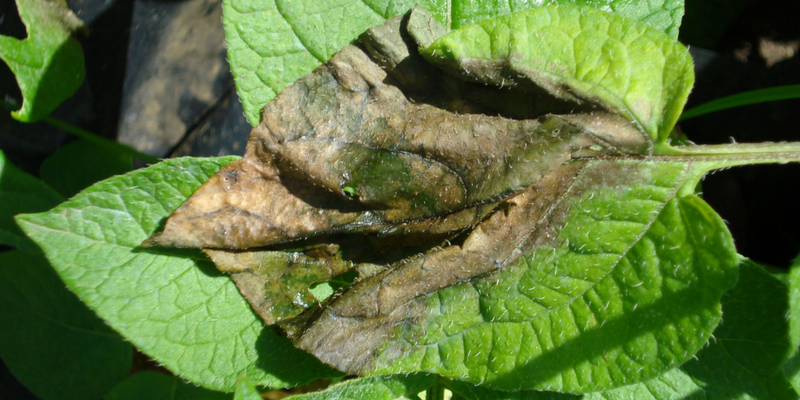
Late blight is equally devasting on potatoes (pictured) as it is on tomatoes, and the lesions look the same. Photo credit: Cornell Cooperative Extension.
Symptoms: Black or dark brown lesions form on the lowest leaves, stems and fruit. These lesions often ooze and are not confined to the vein patterns of the leaves. If the underside of an affected leaf has a powdery appearance, the fungus has progressed to sporulation and you definitely have late blight. If you see no powdery sporulation, tuck an affected leaf into a closed plastic bag with a moist paper towel overnight. If it sporulates, you have late blight. If it does not, you likely don’t.
Cause: Late blight is caused by a fungus, Phytophthora infestans, whose Latin name translates to ‘all-consuming plant destroyer.’ It overwinters in southern climates that don’t freeze, traveling North on the wind each summer. It doesn’t overwinter in your garden, is the good news.
Management: Pull affected plants and twine trellising immediately, securely closing the bag you put them in. Send them, without second thought, to the landfill. Remove stakes or cages that held the diseased plants and rinse them in a dilute bleach solution to kill any remnant spores.
Prevention: Start with disease-resistant varieties, like Summer’s Sweetheart or Chiapas. Hop on over to the 5 Keys to Preventing Tomato Disease for the full scoop. Also, late blight can affect potatoes, so stay vigilant. Just to play it safe, harvest every potato you can and pull any volunteer potatoes the following spring.
Seed Saving: Late blight only overwinters in living tissue, so save the seeds from fruits of suffering plants with confidence, the earlier the better.
3. Early Blight
Early blight is a drag, but when identified early and managed well, you’ll enjoy many weeks of production following.
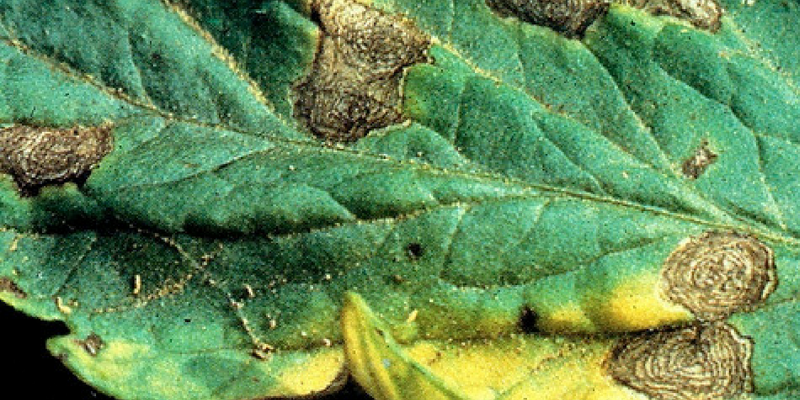
Concentric rings are the signature of early blight. Photo credit: Cornell Cooperative Extension.
Symptoms: The dark brown lesions of early blight have diagnostic concentric rings, like a coffee-stained topo map. You’ll find the lesions on the lowest leaves, stems and fruit.
Cause: Early blight is caused by another fungus, Alternaria solani, which only overwinters in southern climates that don’t freeze. Early blight travels North on the wind each summer. Fortunately, it doesn’t survive the winter in here in the Northeast.
Management: As soon as you identify early blight on your tomatoes, strip each affected leaf and fruit and securely close the bag you put them in. Send them, without second thought, to the landfill. If you’ve caught early blight early, you’ll likely enjoy another three to four weeks of production.
Prevention: Start with disease-resistant varieties, like Summer’s Sweetheart or Chiapas. Hop on over to the 5 Keys to Preventing Tomato Disease for the full scoop.
Seed Saving: Early blight is, alas, seed-borne. Resist the temptation to save seeds from plants affected by early blight.
4. Septoria Leaf Spot
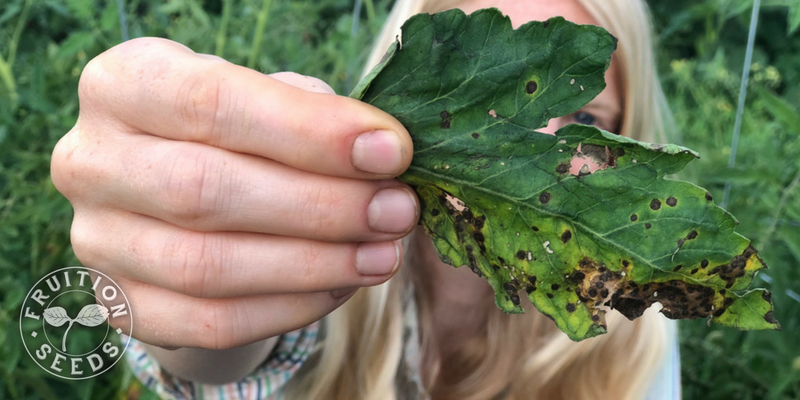
Identify septoria leaf spot early and you’ll enjoy another month of harvest.
Symptoms: Septoria leaf spot can look similar to early blight, but its dark brown lesions lack the concentric rings and are more small and ‘spotty.’ Lowest leaves are affected first.
Cause: Septoria leaf spot is caused by yet another fungus, Septoria lycopercici. Similar to early and late blights, septoria overwinters only in southern climates that don’t freeze, traveling North on the wind each summer. Fortunately, it doesn’t survive the winter in here in the Northeast.
Management: Similar to early blight, as soon as you identify septoria on your tomatoes, strip each affected leaf and fruit and securely close the bag you put them in. Send them, without second thought, to the landfill. If you’ve caught septoria leaf spot early, you’ll likely enjoy another three to four weeks of production.
Prevention: Start with disease-resistant varieties, like Summer’s Sweetheart or Chiapas. Hop on over to the 5 Keys to Preventing Tomato Disease for the full scoop.
Seed Saving: Septoria is not transmitted by seed, so save the seeds from fruits of suffering plants with confidence, the earlier the better.
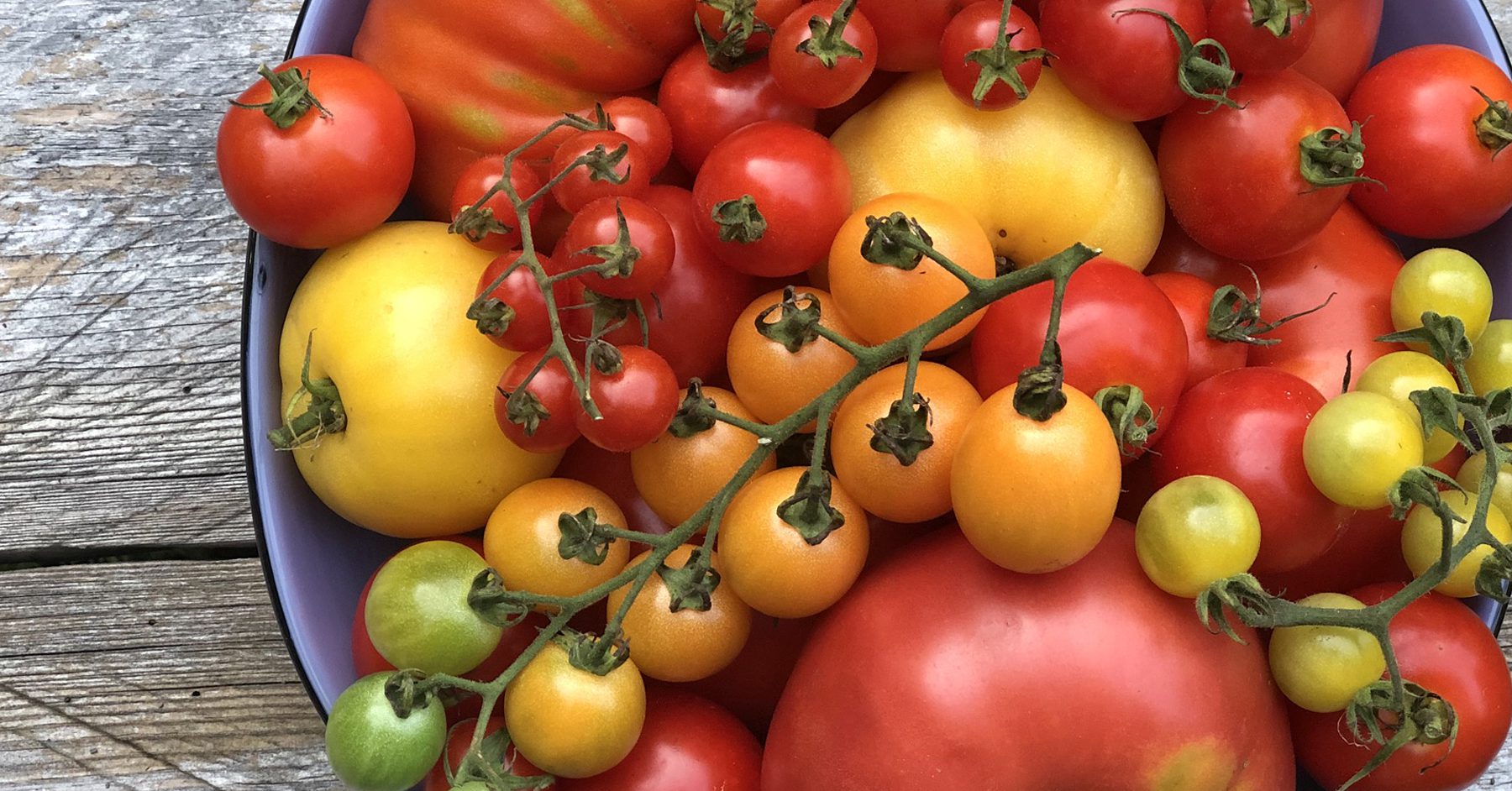
5. Brown Rugose
This virus can affect tomato and peppers; current research shows Tomato Brown Rugose Virus does not affect eggplant, tomatillos, potatoes, and other common solanaceae species. To learn more about ToBRFV, the American Seed Trade Association shares this resource and here are three additional sources we trust, shared with us by our colleagues at Cornell:
- https://www.canr.msu.edu/news/tobrfv-a-new-concern-for-tomato-and-pepper-producers
- https://onlinelibrary.wiley.com/doi/10.1111/epp.12711
- https://www.vegetables.cornell.edu/pest-management/disease-factsheets/tomato-brown-rugose-fruit-virus/
Friends, as an emerging virus in the world, our understanding is limited and as we learn more, as always, we will share more.
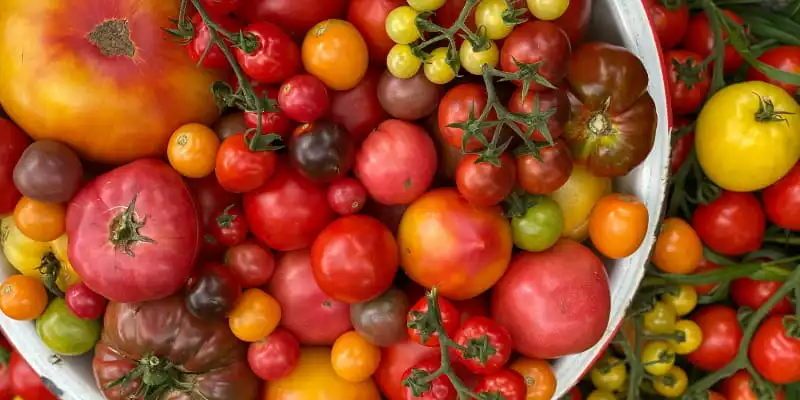
Growing tomatoes is so satisfying, so rewarding. But not without pitfalls. Stay vigilant and keep in touch, Friends!
Sow Seeds & Sing Songs,

and the Many Beings of Fruition

Thank you for the clear pictures and information about tomato diseases.
Can you tell me what causes the top 1/4 of otherwise healthy tomatoes to be yellow and hard?
possible excessive heat…but not sure.
My information shows that Early Blight can overwinter in plant debris in many locations across the USA, including the Northeast.
https://extension.umn.edu/disease-management/early-blight-tomato-and-potato#:~:text=Biology,Alternaria%20tomatophila%20and%20Alternaria%20solani.&text=The%20early%20blight%20pathogens%20both,be%20introduced%20on%20tomato%20transplants.
https://ipm.cahnr.uconn.edu/early-blight-management-in-fresh-market-tomatoes/
Hi David,
Thanks for sharing this with us! Melissa
Thanks. Your videos and newsletters are always so well-produced and informative. It must take a lot of effort.
Hi Dennis, thank you for your kind words and for being the reason why we do what we do! <3 Melissa
I have a half-baked theory that lots of rain depletes tomatoes of nutrients and after a period of big rains fertilizer is welcome.
What do you think?
Hi Auden, Thanks for sharing your theory. You could be on to something. More rain means less sun and you need sun to photosynthesis. <3 Melissa